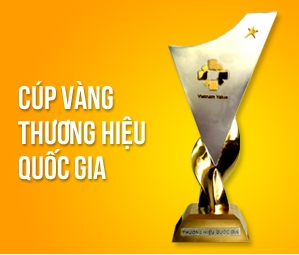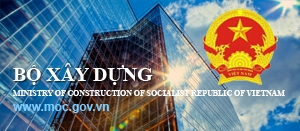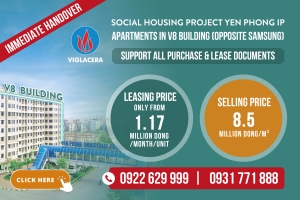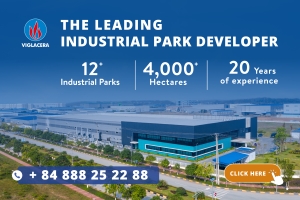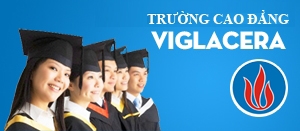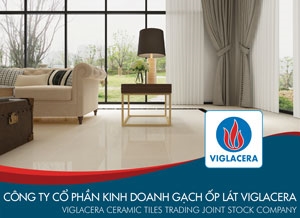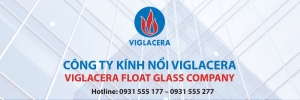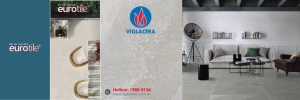Low - E glass, a breakthrough in manufacturing technology of Viglacera
Always a leading company, positively in research and applying the world class of modern science and high technology in production of building materials, VIGLACERA is again making a breakthroughs in technology, while actively investing in project of "Low – E glass production lines"- This project was approved as "high technology" project by the Prime Minister on January 13, 2015.
Intended capacity of Scale 5 million m2/year, the project includes two phases of investment: Phase 1: production line with the capacity of 2.300.000m2/year at Tan Dong Hiep - Di An - Binh Duong; and Phase 2: production lines with the capacity of 2.3 - 2,7 million m2 / year at Bac Ninh province.

Using Low-E glass is the solution for building’s energy saving, protecting the health of users and also a solution to the investment efficiency
Low - E glass is kind of high-performance glass, using the float glass as substrate with ultra-thin coating layer on the surface, high ability to conform the requirements of usability, transparency requirements and the color of the glass, and also low emissivity feature, small coefficient of thermal conductivity, resulting in minimized of transfering the temperature between inside and outside environment through glass wall system, thereby saving energy costs of air conditioner system however, still can maintain the cooling effect in the summer and heating in winter.
Most countries around the world are using Low-E glass with the soft coating of production technology. Because the soft coating glass has advanced features compared to hard-coated glass. In order to meet Vietnamese’s climate conditions and the world’s trend, VIGLACERA also applied the soft coated technology to both Solar Control and Low – E glass products for its "Low-E production line”.

The principle of operation of Low-E glass
Solar Control glass is coated by metallic coating layers non-containing silver, thus could be installed single layer without affecting to the coating reliability. Solar Control glass is capable to prevent the amount of light that the human eye can take from sunlight that reaches about 5 - 95%; for energy from sunlight up to 79% and especially with the ultraviolet lights, the ability to prevent up to 99%. Besides the basic features as Solar Control glass, Low-E glass is coated by silver layer, and have features consistent with the cold weather. Low-E glass ensures that most of the sunlight that human eye can take to illuminate the inside of the house and avoid the loss of temperature from the indoor to the outdoor environment.
Thus, if the glass Solar Control saves energy by reducing the temperature from outside to the house to minimize the cost of using the air conditioner to cool the room, by contrast, Low - E glass saves energy by reducing energy consumption from the uses of heater to warm the room. With this advanced characteristics, Low-E glass of Viglacera will satisfy both hot and cold climates.

Many large building on world are using and promoting radical premium features of Low-E glass
Currently, most of the large buildings on the world are using Low-E glass and the Vietnamese’s big investors also started to use the Low-E glass. In fact, these glasses are not only brings comfort optimizer and enhance the value of the building, but also bring greater efficiency, effectiveness in long-term for Investor Owners. Even in many developed countries have formaly required to use the environmental friendly materials for the building by the law. As assessed by the leading experts in construction, using Low-E glass will bring the solutions to the energy saving efficiency for buildings.
|
Hard coating technology: Hard coating technology (Online Coating) is technology that is coated by chemical evaporation deposition technology (CVD), that means creates a thin film form by linking diffusers, as a result of the reaction between the gas phase to the heated surface.The final product is a hard coating layer and resistance of abrasion, have very strong links with the substrate.With hard coating technology, Low-E glass has high durability of coatinglayer, easy to cut, drill, grind, temperated or cover without affecting the coating.However, the downside is that the product category is limited, technical indicators of energy are not high, not flexibility in switching products, difficulty adjusting the coating thickness, moreover, the high coating thickness is easy to influence on lighting transmission and the transparency of the glass. |
|
Soft coating technology: Soft coating technology (offline coating) are coated by vacuum evaporation technology in physical deposition (PVD).This coating technology is a set of coating processes of a thin film layer that is performed under vacuum conditions, including the positive ions emitted by many different metals. Thesemetallic ions impact on ions of technologial’s air such as Argon, Nitrogen and Oxygen to create different mixtures that result is to create a mechanical link between the coating layers with the substrate. Due coating process using the physical evaporation deposition takes place in a vacuum conditions, therefore this technology called sputtering process.The advantage of soft coating technology is diverse of product categories; Technical indicators of energy is better than hard coated glass;ensure the transparency of the glass;have the ability to adjust the lighting transmission as required of works or climate;flexibility in switching products, but the drawback is low durability of coating layers, mainly used in the box glass and strict requirements when manufacturing. |
Viglacera: Profit of May kept growing exceeded the plan
(22/06/2015)Lượt xem : 3268Viglacera continues achieving higher profits than targeted plan on May. This is one of the important indicators confirming the development of Viglacera and affirmed "credibility" of the entreprises to shareholders.Read moreViglacera will apply Enterprise Resource Planning (ERP) for the entire Office of the Corporation, subsidiaries and affiliates which Viglacera holds majority of shares
(02/06/2015)Lượt xem : 3146Recently, ERP Steering Committee of Viglacera Corporation - JSC held a meeting to set plans for ERP implementation (period 2015 – 20160) based on the "Survey and assessment report of capability to deploy ERP" in 6 units as mentioned in the first meeting session.Read moreClinker brick "not afraid" of toxic chemicals, against impacts from acid
(02/06/2015)Lượt xem : 4296Playing a leading role and proactive investment in applying scientific and advanced technologies in the field of production of building materials (building materials), "King of materials" from the North - Viglacera newly commissioned clinker tiles production lines at Viglacera’s clinker tiles Joint Stock Company, especially right on the anniversary day of Vietnam Science and Technology and the 125th anniversary of the birth of President Ho Chi Minh. Viglacera’s clinker tiles production line is the most advance in Vietnam with imported technology and key equipment from famous manufacturers of Europe.Read moreViglacera in cooperation with Vietnam Development Bank (VDB) in financing investment credit, export credit, loan guarantees in commercial banks
(13/05/2015)Lượt xem : 3709On 25/04/2015, Viglacera Corporation - JSC and Vietnam Development Bank - Branch I signed a cooperation agreement on financing/funding investment credit, export credit, loan guarantees in commercial banks in commercial banks.Read moreChamber of Commerce President and Ambassador Extraordinary and Plenipotentiary of the Republic of Cuba in Vietnam will be directly involved in establishment of building material production joint-venture between Viglacera and Cuba
(13/05/2015)Lượt xem : 3192In the afternoon of 14/04/2015, Mr. Orlando Hernandez Guillen - Cuban Chamber of Commerce President and Mr. Hermino Lopez Diaz - Ambassador Extraordinary and Plenipotentiary of the Republic of Cuba in Vietnam visited and worked at Viglacera Corporation - JSC on joint venture establishment procedures for ceramic tile, sanitary ware production in Cuba.Read moreApril, 2015: The Viglacera’s consolidated profit gains 15% comparing to planned target
(06/05/2015)Lượt xem : 2773The Viglacera’s profit gains 15% higher than planned, the cumulative profit of first 4 months reached 27% of yearly plan that increase 2.5 times comparing first 4 months of year 2014; monthly revenues reached 1.188 billion, higher than 1% to the plan, the cumulative revenue of first 4 months reached 31% of yearly plan and raise 59% over the same period in 2014.Read more



